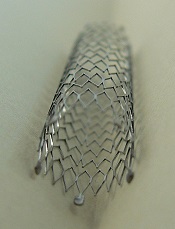
Photo by Frank C. Müller
Extended-duration dual antiplatelet therapy (DAPT) does not appear to confer any benefits for patients implanted with a bare-metal stent (BMS), according to a study published in JAMA.
An additional 18 months of DAPT among patients with a BMS did not result in significant differences in rates of stent thrombosis, major adverse cardiac and cerebrovascular events, or moderate or severe bleeding, compared to patients who received placebo.
Study authors noted, however, that the sample of BMS patients studied was small, which makes it difficult to draw definitive conclusions.
Dean J. Kereiakes, MD, of the Christ Hospital Heart and Vascular Center in Cincinnati, Ohio, and his colleagues conducted this research.
They analyzed 11,648 patients who received a BMS (n=1687) or drug-eluting stent (n=9961) and had completed 12 months of DAPT without bleeding or ischemic events.
The patients were randomized to continue DAPT—thienopyridine and aspirin—or receive placebo and aspirin for months 12 through 30.
Among the BMS patients, rates of stent thrombosis were 0.5% in the DAPT arm and 1.11% in the placebo arm (P=0.24).
Rates of major adverse cardiac and cerebrovascular events (a composite of death, heart attack, and stroke) were 4.04% and 4.69%, respectively (P=0.72). And rates of moderate/severe bleeding were 2.03% and 0.90%, respectively (P=0.07).
Among all the patients analyzed (both types of stent), the rates of stent thrombosis were 0.41% for patients who received DAPT and 1.32% for those who received placebo (P<0.001).
Rates of major adverse cardiac and cerebrovascular events were 4.29% and 5.74%, respectively (P<0.001). And rates of moderate/severe bleeding were 2.45% and 1.47%, respectively (P<0.001).
Dr Kereiakes and his colleagues noted that fewer BMS patients were enrolled in this trial because of the prevailing use of drug-eluting stents in clinical practice.
So the study may have been underpowered to identify differences in adverse events among BMS patients, and additional trials are needed to confirm the results of this research.


